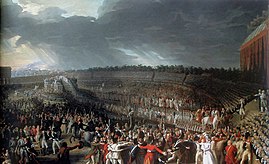Rythenean Revolution
| Rythenean Revolution | |||||||
|---|---|---|---|---|---|---|---|
| |||||||
| |||||||
| Belligerents | |||||||
|
|
| ||||||
| Commanders and leaders | |||||||
|
|
| ||||||
| Strength | |||||||
| 58,000 | 43,000 | ||||||
| Casualties and losses | |||||||
| 19,000 | 17,000 | ||||||
The Rythenean Revolution, also known as the Rythenean Revolutionary Wars, was the republican revolt against the monarchy between 1790 and 1793, and later again in 1824. The revolutionaries defeated the royalists in the war, which caused the overthrow of the seven-hundred year old regime, and the establishment of the First Republic.
Revolutionary tensions first arose after Charles IV revoked the 1622 International Market Act in 1786, which removed the upper classes' rights to trade with parts of the Second Sabarine Empire following the failed War of Succession. As the war was unpopular to begin with, this caused a stir among wealthy traders, who were struggling to find new trading prospects. Many proceeded to smuggle goods, however, Charles began to police the issue by imposing naval patrols throughout the Strait of Casmire. This was seen as an inhibition of the people’s right to free movement as many were left isolated from the mainland, which sparked a wide range of strikes including the famous March on Crown Avenue, where the protesters camped outside the King’s palace for two nights before they were forcefully removed off the premises.
Eventually tensions reached a peak in April 1790, following King Charles’ Proclamation of Dissent which outlawed all political protests and ordered the execution of well known revolutionaries. A week later on the 16th of April, a large mass of citizens in Hyreathe stormed the royal residence and burnt it down in what became popularly known as the ‘spark that ignited the blaze of revolution.’ Following this act of open rebellion, Charles IV declared the need to quash the enemies that opposed the nation’s interests, and war broke out between the royalist and republican forces. The national army dominated the first battles of revolution, however, the establishment of the Delegated Assembly as a war committee and prospective government saw a more unified republican war effort. The conflict ended with the execution of King Charles IV and the founding of the First Republic on 26 November 1793.
Initially headed by President Richard Matthews, the immediate effects of the revolution saw to the acknowledgement of the people’s right to vote, the passing of the first democratic constitution in Rythene, and the enforcement of eighteenth century ideals. As most of the conflict had been fought on the island, the newly founded republic were unable to control the majority of mainland Rythene, and Casmire remained independent from the republic until the second revolution in 1824.
Following the Treaty of Vovaya Kronor in 1816, the monarchy was re-established and John VII (the son of Charles IV) ascended the throne.



